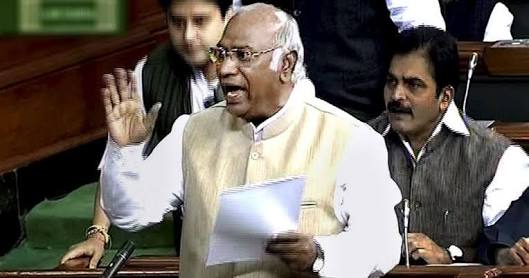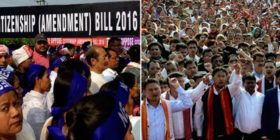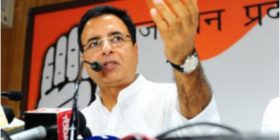After being marginalised in Uttar Pradesh, Maharashtra has emerged as the most important state for the Congress ahead of the 2019 Lok Sabha polls. And it looks like the grand old party is making efforts to get its act together in the premier state in order to make inroads into the newfound Bharatiya Janata Party bastion.
As the ruling NDA in the state is rocked by the Shiv Sena’s revolt, there is more than an opportunity for the Congress to reclaim lost ground. So the appointment of senior leader Mallikarjun Kharge as the general secretary in charge of Congress affairs in the state has come at the right time.
After leading Congress to victory in Karnataka assembly elections under his leadership,Kharge has been made the in charge of Maharashtra at a time when a tie-up between the party and Sharad Pawar’s Nationalist Congress Party is being finalised, and Rahul Gandhi appears to be personally keeping a watch on the developments there.
Maharashtra is traditionally a Congress state. But the grand old party has slowly and gradually lost its influence in the past three decades, and Pawar deciding to part ways with it in 1999 proved to be the proverbial last straw. Earlier, in 1995, the Shiv Sena and BJP alliance came to power, giving a jolt to the Congress.
The 2014 general elections were the nadir of Congress fortunes, as the Narendra Modi wave in the Lok Sabha and assembly elections held soon afterwards not only made pulp of BJP detractors, but also catapulted the saffron party from the number four to number one spot, which might be unprecedented in the history of any state.
Congress finished with just two Maharashtra seats in the Lok Sabha and 42 (out of 288) in the assembly. The NCP was no better, as it finished with four Lok Sabha seats but 41 assembly seats, one less than the Congress. The election saw the end of the 15-year Congress-NCP government in the state.
Seventy-five-year-old Kharge is a phlegmatic leader whose virtues have lately dawned on the Congress high command. When UPA-II was in power, the Dalit leader was a first-timer in Delhi politics, after eight terms as an MLA and having been a senior minister in Karnataka. But in Delhi, he was handed over a passenger ministry like labour and a very brief stint in railways.
He has led the Congress party in the Lok Sabha since May 2014 with aplomb, at a time when Modi and BJP chief Amit Shah were crying hoarse for a “Congress-mukt Bharat” and parliament managers of the ruling party were belittling, targeting and abusing the grand old party day in and day out.”We may be 44 in Lok Sabha, but Pandavas will never be intimidated by a hundred Kauravas,” used to be Kharge’s refrain after taking over four years ago.
At that time, senior leader Kamal Nath, who had been an MP for eight terms, was expecting the task. Amarinder Singh was also hopeful, since he had just defeated Arun Jaitley in Amritsar.
Kharge’s appointment as the party’s leader in the Lok Sabha was a huge shock to the elite power circles of Delhi, with rumours being spread that he got the job due to his Dalit identity. Soon, party leaders realised that Kharge is a great ‘new’ find.
Slow and steady wins the race’ appears to be Kharge’s motto. He showed an aggressive BJP that he cannot be silenced and will fight in the house every which way. He rose to the challenge despite the fact that the Modi dispensation failed to give him the status of leader of the opposition, citing the lack of adequate numbers for the Congress in the Lok Sabha. The Congress tally of 44 has been the lowest in the history of the party and is less than 10% of the 543-member Lower House.
Maharashtra is an “extra-ordinarily” crucial State since it sends 48 MPs to the Lok Sabha, second only to Uttar Pradesh (80 seats).
“It is a calculated step. [We needed] a person with some political heft and experience,” a State leader said. It also helps that Mr. Kharge speaks Marathi and has handled the State in the past.
The challenge ahead in Maharashtra is no different for Kharge, who has his work cut out in making the party fit for the fight. His appointment as general secretary will likely bring unity among the Congress and NCP as they draw up an aggressive strategy in the wake of the Palghar Lok Sabha by-poll, which saw the BJP scraping through to victory.
State leaders have heaved a sigh of relief over Kharge’s appointment, as most of them were fed up with his predecessor, Mohan Prakash, under whom things went from bad to worse. The situation had come to such a pass that some senior state leaders are reportedly not even on talking terms with Prakash.
A plus point for Kharge, a Congress old guard, is that he has a good rapport with Pawar, who is the tallest leader of the alliance in the state. Kharge hails from the border areas of adjoining Karnataka, and is well-versed in the state’s political situation. Added to this is the fact that he can speak fluent Marathi, which will help him connect with grassroots workers.
The message from the by-polls in Palghar and Bhandara-Gondiya, which the BJP lost, is that the Modi wave of 2014 is a thing of the past and the BJP will have to fight for every inch in the days and months ahead.
Though chief minister Devendra Fadnavis is no pushover, he has on hand a battle within the NDA, with the Shiv Sena upping the ante and declaring that it will go solo in all future elections. The Sena has tasted blood, as its nominee lost by less than 30,000 votes in Palghar, where it had sprung a surprise on the BJP by suddenly jumping into the fray. The Sena reiterated its “going solo” line despite the recent visit of BJP chief Amit Shah to ‘Matoshree’ for a 2.5-hour meeting with Thackeray. The Sena is attacking in its mouthpiece Saamna on almost a daily basis.
Though the final decision on the fate of the Sena-BJP tie-up is yet to be announced, it appears clear that a sulking Uddhav Thackeray is in no mood to let bygones be bygones.
The crack in the ruling alliance is good news for Kharge and Pawar, as they can fashion a strategy taking along smaller groups and parties at a time when Modi’s promise of ‘achhe din’ are looking like yet another ‘jumla’.
Rahul Gandhi has pinned much hope on a turnaround in Maharashtra, given the fact that the Congress has been marginalised in UP, Bihar, Tamil Nadu, West Bengal, Andhra Pradesh and Odisha and there is no quick-fix solution.
Besides Maharashtra, the Congress is also hoping for a turnaround in Rajasthan, Madhya Pradesh, Chhattisgarh, Gujarat and Haryana, all states currently held by the BJP.
Kharge will have to contend with several issues, including those the Mumbai Regional Congress Committee following the appointment of Sanjay Nirupam as its chief. His appointment sends the right signal to the Marathas, minorities and Dalits who form the political constituency of the Congress-NCP combine.
Experts say that if the two parties succeed in making a dent in the OBC vote bank of the BJP and the Shiv Sena and attract the urban middle and lower classes, the combine could give the BJP a run for its money.
All in all, an exciting battle is at hand for the Congress in Maharashtra, and Rahul Gandhi has sent his trusted lieutenant to supervise the operation.
Source : The Wire, The Hindu





Leave a reply